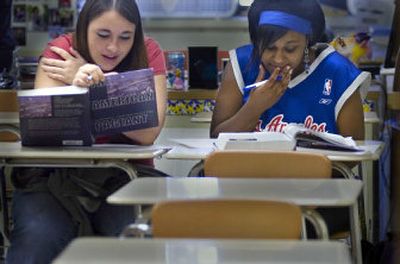Tackling tougher assignments

The number of Spokane high school students taking more challenging courses has more than doubled in the last 10 years.
According to data released by Spokane Public Schools this month, the number of students taking Advanced Placement exams went from 305 in 1996 to 731 in spring 2006.
The Central Valley School District, Spokane County’s second largest district, also saw dramatic increases in the number of students willing to take more rigorous, college-level courses while still in high school, school officials said.
University High School administered 206 tests this year, up from 95 in 1999.
“More and more colleges aren’t taking kids who don’t take a high school Advanced Placement class,” said Karrie Docterman, an AP history teacher at Rogers High School. “We are continually telling them if you want to go to college … this is the way to do it.”
The Advanced Placement program allows students to take college-level courses from teachers at local high schools who receive training through the AP program.
Students take an exam in the spring to determine whether they learned enough to skip certain required courses in college, and some students receive college credit.
“They see AP as a gate to get through and be prepared for college,” said Nancy Stowell, associate superintendent for Spokane schools.
However, some schools have more AP course offerings than others, statistics show. Schools with a high population of low-income students tend to have fewer students taking the high-level exams.
Rogers High School, where 66 percent of the students qualify for free and reduced-price lunches, administered only 92 tests in nine subject areas, compared with 511 tests taken at Lewis and Clark High School in 17 subject areas. Lewis and Clark has a 28 percent poverty rate, as measured by the lunch program. North Central High School, with a 43 percent poverty rate, administered 240 tests.
“It’s about creating access for kids and we are working really hard on that,” said Rogers Principal Carole Meyer. “We want a culture where kids take more and more challenging courses. … That’s starting to evolve.”
Rogers plans to increase the number of students taking AP courses by 65 percent over the next three years, Meyer said. “Last year we had single digit number of kids in an AP (biology) class; this year we have just under 60,” Meyer said.
The number of teachers qualified to teach the classes, and student interest in the courses, also vary by school and affect the number of courses available. At Lewis and Clark there are 14 AP teachers, while Rogers has seven, with a growing demand.
“Colleges are so competitive,” said Jamie Holcomb, a junior at Rogers who takes AP American history.
The course, which covers American history from 1400 to 1970 in one year, requires a college textbook and weekly essays.
“I’ve taken more notes in the last two weeks than I have my entire life,” Holcomb said.